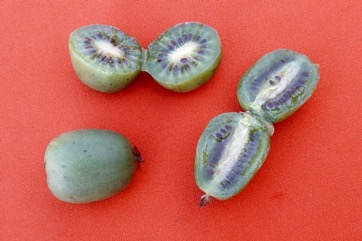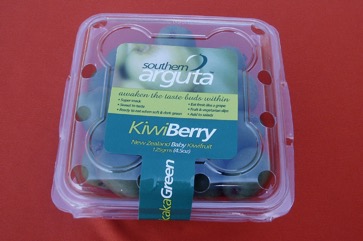Hardy Kiwi

A temperate plant. It needs 150 frost free days. During the dormant period is can withstand heavy frosts. All selections need a chilling requirement to flower and fruit. They prefer a sunny position. It needs protection from strong winds. They need a well drained somewhat acid (pH 5-6.5) soil. The plants will not tolerate salty soils. They need plenty of water during the growing season. It occurs naturally climbing up trees in woodland at elevations of 100 - 2000 metres in China and Japan. It suits hardiness zones 4-9. In Sichuan and Yunnan.
Also known as:
Bower actinidia, Bower vine, Chamdarae, Cocktail kiwi, Darae, Dessert kiwi, Kokuwa, Sarunashi, Siberian gooseberry, Tara Vine, Tarae, Yang-tao
Synonyms
- Trochostigma argutum Siebold & Zucc.
- Actinidia megalocarpa (Nakai.)
- Trochostigma arguta (Siebold. & Zucc.)
Edible Portion
- Fruit, Leaves, Sap, Vegetable
Where does Hardy Kiwi grow?
Found in: Asia, Australia, Britain, Canada, China, Japan, Korea, Lithuania, Manchuria, New Zealand, North America, North Korea, Poland, Russia, Siberia, Taiwan, Tibet, United States
Notes: The fruit contains up to 5 times the vitamin C content of blackcurrants. There are 62 Actinidia species. The Actinidiaceae are a mainly tropical family.
Growing Hardy Kiwi
Cultivation: The plants need a trellis to climb over. Plants benefit from being well mulched but mulch should not touch the vine. Winter pruning is important. Cuttings can be used. Soft wood cuttings are used.
Edible Uses: The sap of the vine can be tapped and drunk in the spring. The fruit are eaten raw or cooked. They can be eaten whole without peeling. The dried leaves are used for seasoning vegetable dishes.
Production: Fruit are produced on second year wood and on fruit spurs on older wood. Plants produce fruit after 4 years on grafted vines. They are best ripened on the vine but have shorter shelf life.
Nutrition Info
per 100g edible portion| Edible Part | Energy (kcal) | Protein (g) | Iron (mg) | Vitamin A (ug) | Vitamin c (mg) | Zinc (mg) | % Water |
|---|---|---|---|---|---|---|---|
| Fruit | - | - | - | - | - | - | |
| Leaves | - | - | - | - | - | - | |
| Sap | - | - | - | - | - | - |
Hardy Kiwi Photos


References
Ann. Mus. Bot. Lugdano-Batavum 3:15. 1867
Bircher, A. G. & Bircher, W. H., 2000, Encyclopedia of Fruit Trees and Edible Flowering Plants in Egypt and the Subtropics. AUC Press. p 9
Brickell, C. (Ed.), 1999, The Royal Horticultural Society A-Z Encyclopedia of Garden Plants. Convent Garden Books. p 76
Chen, B. & Qiu, Z., Consumer's Attitudes towards Edible Wild Plants, Ishikawa Prefecture, Japan. p 22 www.hindawi.com/journals/ijfr/aip/872413.pdf
Crandall, C & Crandall, B., 1996, Flowering Fruiting and Foliage vines. Sterling. p 88
Cundall, P., (ed.), 2004, Gardening Australia: flora: the gardener's bible. ABC Books. p 96
Facciola, S., 1998, Cornucopia 2: a Source Book of Edible Plants. Kampong Publications. p 2
Flowerdew, B., 2000, Complete Fruit Book. Kyle Cathie Ltd., London. p 134
Hu, Shiu-ying, 2005, Food Plants of China. The Chinese University Press. p 549
INFOODS:FAO/INFOODS Databases
John, L., & Stevenson, V., 1979, The Complete Book of Fruit. Angus & Robertson p 111
Joyce, D., 1998, The Garden Plant Selector. Ryland, Peters and Small. p 176
Ju, Y., et al, 2013, Eating from the wild: diversity of wild edible plants used by Tibetans in Shangri-la region, Yunnan, China, Journal of Ethnobiology and Ethno medicine 9:28
Lim, S., et al, 2016, Inhibition of hardy kiwifruit (Actinidia arguta) ripening by 1-methylcyclopene during cold storage and anticancer properties of the fruit extract. Food Chemistry 190:150-157
Lyle, S., 2006, Discovering fruit and nuts. Land Links. p 47
Morton, J. F., 1987, Fruits of Warm Climates. Wipf & Stock Publishers p 299
Ong, H. G., et al, 2015, Ethnobotany of the wild edible plants gathered in Ulleung Island, South Korea. Genet Resourc crop Evol. Springer
Pemberton, R. W. & Lee, N. S., 1996, Wild Food Plants in South Korea: Market Presence, New Crops, and Exports to the United States. Economic Botany, Vol. 50, No. 1, pp. 57-70
Plants for a Future database, The Field, Penpol, Lostwithiel, Cornwall, PL22 0NG, UK. http://www.scs.leeds.ac.uk/pfaf/
Reich, Lee, 1991, Uncommon Fruits Worthy of Attention. Addison-Wesley, pp 121-138
Self, M., 199, Phoenix Seeds catalogue. p 17
Song, M., et al, 2013, Traditional knowledge of wild edible plants in Jeju Island, Korea. Indian Journal of Traditional Knowledge. 12(2) pp 177-194
USDA, ARS, National Genetic Resources Program. Germplasm Resources Information Network - (GRIN). [Online Database] National Germplasm Resources Laboratory, Beltsville, Maryland. Available: www.ars-grin.gov/cgi-bin/npgs/html/econ.pl (10 April 2000)
World Checklist of Useful Plant Species 2020. Royal Botanic Gardens, Kew